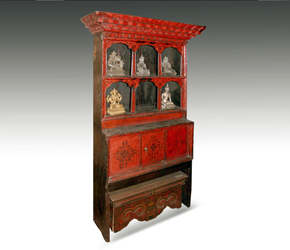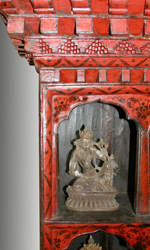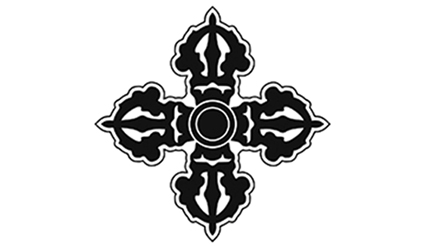Tibetan Torgam or Chosum Altar Cabinet
 |
|
"This Tibetan torgam or chosum altar cabinet is estimated to be in excess of 200 years old. It is part of a particular class of cabinets called torgam, in essence, shrines or altars made to house ceremonial sculptures, especially those fashioned from butter and barley meal called torma"
Only recently has it become possible to discover the full range of Tibetan furniture, since little emerged until the 1980s, when this type of material first began to appear on the international art market. Up until that point, the furniture remained where it was used, primarily in monasteries and a scant amount in homes. However, during the Cultural Revolution in China all this changed. Most of Tibet’s monasteries were destroyed and the furniture that was found there and in homes was either carted over the Himalayas by those fleeing the country, finding its way to India; or was sold to the Chinese by others who used this money to escape.
 |
|
Regardless of how this furniture first began to appear on the market, there does not seem to ever have been much furniture in Tibet to begin with, primarily because the population of Tibet has always been small and traditional ways of life for ordinary people did not require any significant amount of furniture. Even the aristocracy, composed of government officials, religious leaders, and their families used a limited number of furniture types compared to other cultures. For example, no tradition developed of making seating or beds because the vast majority of Tibetans preferred to sit and sleep either on the ground or low, cushioned wooden platforms. Household goods were commonly hung from the walls, and those used less frequently were stored in woolen sacks or yak skin bags. Only precious goods such as finery and jewelry might be deposited in a special chest, and this chest would be found in the religious rooms of the monasteries, houses or tents where Tibetans typically lived.
Consequently, there are a limited number of Tibetan furniture types. Essentially, the vast majority of Tibetan furniture falls into three basic categories: trunks and boxes (essentially a box accessible through a lid), cabinets (boxes accessible through doors), and tables. A fourth type of furniture – shrines or altars – might be considered in a broader discussion of this furniture; however, tables were commonly used as altars upon which was placed offerings such as fruit, incense, butter lamps and if available, statuary. It was very rare that individual pieces were designed as altars alone, making this piece particularly rare; and because statuary was primarily found in monasteries as opposed to homes, it can be said with some degree of certainty this altar was originally used in a monastery. It is important to remember that the monasteries were the social, political, economic, and religious hub of Tibetan life, and many activities occurred there beside education and activities associated with Buddhist worship.
Almost all Tibetan furniture was painted as this helped hide the simple joinery of the furniture and Tibetan taste preferred vivid painting to the subtlety of wood grain. The virtual absence in Tibet of high humidity and insect pests, the two main agents of the destruction of wood, as well as the protective coating of butter-lamp soot and the comparative safety of the monasteries allowed for the preservation of pieces which now have considerable age. This altar, for example, is estimated to be in excess of 200 years old. It is part of a particular class of cabinets called torgam, in essence, shrines or altars made to house ceremonial sculptures, especially those fashioned from butter and barley meal called torma. If the torma depicted fierce guardian deities, then the torgam was fashioned with doors and the statues were concealed. If not, the face was open as in this piece, and in this case the torgam was known as a chosum. In either case, the torgam was kept in a special shrine room called a gokhang found in the monastery (or sometimes in the wealthiest of homes). The torgam is possibly the first type of furniture to be developed to address a specific requirement of Tibetan Buddhist ritual and practice. Few authentic examples are found today.
Finally, in regard to the painting, it can be said that Tibetan taste favored certain motifs and formats that were derived from early, commonly held, Buddhist decorative arts traditions as opposed to arts traditions from surrounding cultures. Sometimes, strictly religious motifs were tempered by embellishment, alteration or abstraction to perform a more decorative function so the piece might be considered more pleasing to the eye. Also, it was extremely common that central motifs were surrounded by borders of repeated floral or geometric designs. This is true of this altar as well. On the face are three central medallions which represent stylized “double dorjes.” The double dorje is one of the premier symbols in Tibetan Buddhism. It represents pure consciousness or the awareness which lies beyond conceptual thinking. The Sanskrit word for this state of mind is “sunyata,” which is typically translated as emptiness or void. It is a state that cannot be destroyed or corrupted in which all negative and deluded conditions cease to exist. In certain types of ritual the double dorje acts as a tool to break the bonds of worldly attachment to reach sunyata. A reference to this symbol on any type of furniture from Tibet would be considered auspicious.
Download this Article: Tibetan Torkam or Chosum Altar Cabinet.pdf
